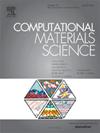POAT:通过点向距离分布和偏移注意力从有限数据中预测材料性能
IF 3.3
3区 材料科学
Q2 MATERIALS SCIENCE, MULTIDISCIPLINARY
引用次数: 0
摘要
材料的性质决定了材料的各种应用。在过去的几十年里,材料的性能通常是通过反复试验来确定的,这是缓慢而昂贵的,或者是密度泛函理论(DFT)计算,这是计算密集型的,并且在材料结构方面受到限制。最近,一种称为点向距离分布(PDD)的编码方法在表示晶体结构方面取得了令人印象深刻的成果。然而,该方法无法有效处理复杂结构晶体的周期性和致密性问题,不利于预测材料性能。本文提出了一种基于点向距离分布编码和偏移注意机制(POAT)的变压器模型。该网络可以灵活地表示晶体结构,有效地处理晶体的周期性和密集性问题。在JARVIS-DFT和MatBench结构数据集上的数值实验表明,所提出的模型在大多数属性预测任务中都达到了最先进的性能,特别是在训练数据有限的情况下表现出了较好的鲁棒性。与图网络模型相比,POAT模型在训练和预测时间上也显示出显著的效率优势。一项消融研究进一步探讨了偏移注意机制在POAT模型中的重要性。并将所建立的模型应用于热容预测,进一步说明了该模型的通用性。本文章由计算机程序翻译,如有差异,请以英文原文为准。

POAT: Material property prediction from limited data via Pointwise Distance Distribution and Offset Attention
The properties of the material determine the various applications of the material. In the last decades, material properties have often been determined through trial-and-error experiments, which are slow and costly, or Density Functional Theory (DFT) calculations, which are computationally intensive and limited in terms of material structure. Recently, an encoding method called Pointwise distance distribution (PDD) has achieved impressive results in representing crystal structures. However, this method is unable to effectively deal with the periodicity and denseness problems of crystals with complex structures, which is not conducive to predicting material properties. In this paper, we propose a transformer model based on Pointwise distance distribution encoding and Offset ATtention mechanism (POAT). Our network can represent crystal structures in a flexible manner and effectively handle crystal periodicity and denseness problems. Numerical experiments on the JARVIS-DFT and MatBench structure datasets show that the proposed model achieves the state-of-the-art performance in most of the property prediction tasks, particularly demonstrating superior robustness when the training data is limited. The POAT model also shows significant efficiency advantages in training and prediction time compared to graph network models. An ablation study further investigates the importance of the offset attention mechanism in the POAT model. Furthermore, the developed model is applied to predict the heat capacity, further illustrating the versatility of the model.
求助全文
通过发布文献求助,成功后即可免费获取论文全文。
去求助
来源期刊

Computational Materials Science
工程技术-材料科学:综合
CiteScore
6.50
自引率
6.10%
发文量
665
审稿时长
26 days
期刊介绍:
The goal of Computational Materials Science is to report on results that provide new or unique insights into, or significantly expand our understanding of, the properties of materials or phenomena associated with their design, synthesis, processing, characterization, and utilization. To be relevant to the journal, the results should be applied or applicable to specific material systems that are discussed within the submission.
 求助内容:
求助内容: 应助结果提醒方式:
应助结果提醒方式:


